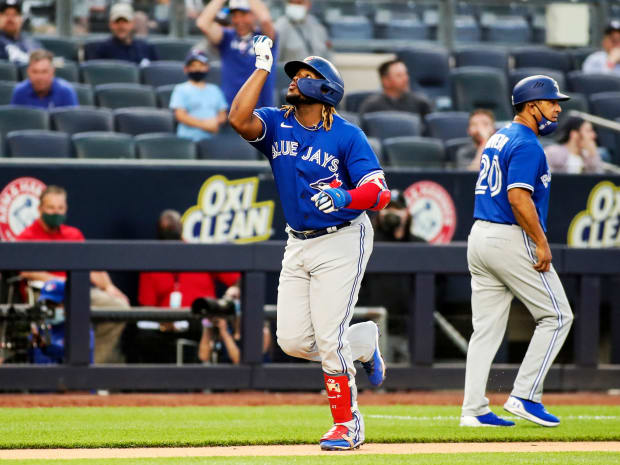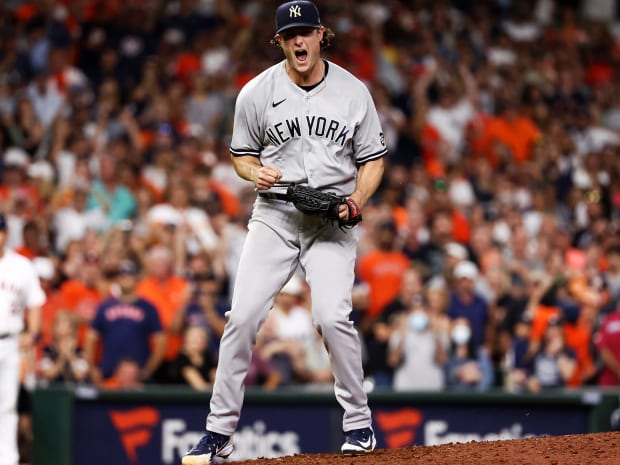The Blue Jays star is treating the race with Shohei Ohtani as he does fastballs over the plate: he’s conceding nothing.
Welcome to The Opener, where every weekday morning you’ll get a fresh, topical column to start your day from one of SI.com’s MLB writers.
What Shohei Ohtani is doing is so unique and elite that maybe he cannot be caught as the American League MVP. He leads the league in homers and slugging while striking out 11.7 batters per nine innings over 13 starts. But Vladimir Guerrero Jr. is treating that race as he does fastballs over the plate: He is conceding nothing.
Guerrero has his own trump card to play: the Triple Crown. Guerrero trails Ohtani by just three homers while leading the league in batting average and RBI. He is on pace to hit 55 homers and bat .332. Only three players ever have reached those thresholds, none in the past 89 years: Jimmie Foxx, Hack Wilson and Babe Ruth (twice). And all of them when they did so were older than Guerrero, who is 22.

What makes Guerrero such a devastating hitter is not just a flat, powerful swing that turns around any velocity at any height. (He is hitting .399 and slugging .757 against fastballs.) It is also that Guerrero is supremely disciplined at the plate. Much has been made of his weight loss as the key to his breakout season. The bigger impact has been made by his improved selection of what pitches to attack. Guerrero has dropped his chase rate from 28.9% in 2019 to 21.9% this year. He has more hits on pitches in the strike zone than any hitter in baseball.
Add up his hitting profile—massive power, elite contact, superb pitch selection and the way he almost never gets off balance at the plate by being fooled—and Guerrero is reminiscent of Manny Ramírez. And to complete the comparison, look at the close resemblance to the start of their careers:
First 273 Career Games
There is one more element that could swing some voters toward Guerrero: a playoff spot. Toronto has a 67% chance of playing in the postseason. Their rotation is better than you think, with pitching coach Pete Walker turning Robbie Ray into a strike-thrower and rookie Alek Manoah making an impact. Ray, Manoah, Hyun Jin Ryu and Steven Matz are 27–14. The bullpen, which has run through 26 relievers, could use a power arm such as Craig Kimbrel.
The Jays play seven of their next 10 games against Boston, then come home to Toronto to play their first games at Rogers Centre in almost two years—an almost guaranteed emotional boost for the club in the second half.
Guerrero, who has played in every game, could have more meaningful September moments than Ohtani—the kind of moments that can leave an impression with MVP voters. And the Blue Jays finish with 14 of their last 23 games against Baltimore and Minnesota, two of the three worst pitching staffs in the AL.
Ohtani remains the clear favorite to win the MVP. But Guerrero is on his own historical path to possibly create a debate with echoes of 1941 (Joe DiMaggio over Ted Williams) and 2012 (Miguel Cabrera over Mike Trout).

New York Yankees ace Gerrit Cole has made the adjustment in baseball’s crackdown period on sticky substances. The spin rates are down on his fastball (-184 rpms) and slider (-180 rpms), but so are the batting averages against those pitches. How has he done it?
After struggling with poor fastball command—and getting pounded in a start at Boston on May 31—Cole made a key change in his next outing. He moved from the center of the rubber to the far first-base side. His ERA this month is 2.45—down from 4.65 in June—and he has cut his percentage of pitches in the middle of the plate from 28% to 23%.
In 2019, when he “learned” how to spin fastballs with Houston, Cole threw 340 fastballs at 2,600 rpms or more. In June and July, with the crackdown in place, he has thrown just three such pitches. His high-spin heater disappeared virtually overnight. But Cole is proving that he is still an elite pitcher without ridiculously high spin rates.
Monday marks one month since the enforcement phase of the sticky-substances crackdown began. Overall batting average and slugging are up while RPMs dropped by an average of 72.
Biggest Change in Overall Spin Rate
Least Change in Overall Spin Rate
More MLB Coverage:
• Second-Half Mysteries: Inside MLB's Thrilling Stretch Run
• Five ‘Angel and Devil’ Trade Deadline Conversations
• In the Year of Ohtani, MLB’s Stars Are Celebrating the Greatest of Them All
• Three Big Questions Ahead of the MLB Trade Deadline
The Blue Jays star is treating the race with Shohei Ohtani as he does fastballs over the plate: he’s conceding nothing.
Welcome to The Opener, where every weekday morning you’ll get a fresh, topical column to start your day from one of SI.com’s MLB writers.
What Shohei Ohtani is doing is so unique and elite that maybe he cannot be caught as the American League MVP. He leads the league in homers and slugging while striking out 11.7 batters per nine innings over 13 starts. But Vladimir Guerrero Jr. is treating that race as he does fastballs over the plate: He is conceding nothing.
Guerrero has his own trump card to play: the Triple Crown. Guerrero trails Ohtani by just three homers while leading the league in batting average and RBI. He is on pace to hit 55 homers and bat .332. Only three players ever have reached those thresholds, none in the past 89 years: Jimmie Foxx, Hack Wilson and Babe Ruth (twice). And all of them when they did so were older than Guerrero, who is 22.

What makes Guerrero such a devastating hitter is not just a flat, powerful swing that turns around any velocity at any height. (He is hitting .399 and slugging .757 against fastballs.) It is also that Guerrero is supremely disciplined at the plate. Much has been made of his weight loss as the key to his breakout season. The bigger impact has been made by his improved selection of what pitches to attack. Guerrero has dropped his chase rate from 28.9% in 2019 to 21.9% this year. He has more hits on pitches in the strike zone than any hitter in baseball.
Add up his hitting profile—massive power, elite contact, superb pitch selection and the way he almost never gets off balance at the plate by being fooled—and Guerrero is reminiscent of Manny Ramírez. And to complete the comparison, look at the close resemblance to the start of their careers:
First 273 Career Games
There is one more element that could swing some voters toward Guerrero: a playoff spot. Toronto has a 67% chance of playing in the postseason. Their rotation is better than you think, with pitching coach Pete Walker turning Robbie Ray into a strike-thrower and rookie Alek Manoah making an impact. Ray, Manoah, Hyun Jin Ryu and Steven Matz are 27–14. The bullpen, which has run through 26 relievers, could use a power arm such as Craig Kimbrel.
The Jays play seven of their next 10 games against Boston, then come home to Toronto to play their first games at Rogers Centre in almost two years—an almost guaranteed emotional boost for the club in the second half.
Guerrero, who has played in every game, could have more meaningful September moments than Ohtani—the kind of moments that can leave an impression with MVP voters. And the Blue Jays finish with 14 of their last 23 games against Baltimore and Minnesota, two of the three worst pitching staffs in the AL.
Ohtani remains the clear favorite to win the MVP. But Guerrero is on his own historical path to possibly create a debate with echoes of 1941 (Joe DiMaggio over Ted Williams) and 2012 (Miguel Cabrera over Mike Trout).

New York Yankees ace Gerrit Cole has made the adjustment in baseball’s crackdown period on sticky substances. The spin rates are down on his fastball (-184 rpms) and slider (-180 rpms), but so are the batting averages against those pitches. How has he done it?
After struggling with poor fastball command—and getting pounded in a start at Boston on May 31—Cole made a key change in his next outing. He moved from the center of the rubber to the far first-base side. His ERA this month is 2.45—down from 4.65 in June—and he has cut his percentage of pitches in the middle of the plate from 28% to 23%.
In 2019, when he “learned” how to spin fastballs with Houston, Cole threw 340 fastballs at 2,600 rpms or more. In June and July, with the crackdown in place, he has thrown just three such pitches. His high-spin heater disappeared virtually overnight. But Cole is proving that he is still an elite pitcher without ridiculously high spin rates.
Monday marks one month since the enforcement phase of the sticky-substances crackdown began. Overall batting average and slugging are up while RPMs dropped by an average of 72.
Biggest Change in Overall Spin Rate
Least Change in Overall Spin Rate
More MLB Coverage:
• Second-Half Mysteries: Inside MLB's Thrilling Stretch Run
• Five ‘Angel and Devil’ Trade Deadline Conversations
• In the Year of Ohtani, MLB’s Stars Are Celebrating the Greatest of Them All
• Three Big Questions Ahead of the MLB Trade Deadline


0 Comments